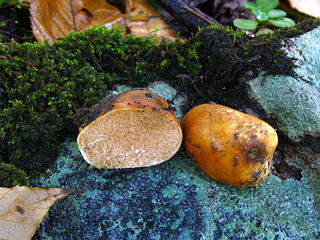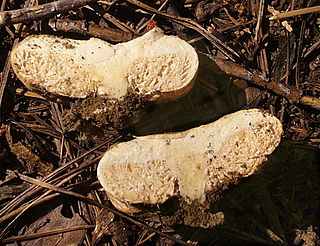
The Russulaceae are a diverse family of fungi in the order Russulales, with roughly 1,900 known species and a worldwide distribution. They comprise the brittlegills and the milk-caps, well-known mushroom-forming fungi that include some edible species. These gilled mushrooms are characterised by the brittle flesh of their fruitbodies.

Lactarius is a genus of mushroom-producing, ectomycorrhizal fungi, containing several edible species. The species of the genus, commonly known as milk-caps, are characterized by the milky fluid ("latex") they exude when cut or damaged. Like the closely related genus Russula, their flesh has a distinctive brittle consistency. It is a large genus with over 500 known species, mainly distributed in the Northern hemisphere. Recently, the genus Lactifluus has been separated from Lactarius based on molecular phylogenetic evidence.

Milk-cap is a common name that refers to mushroom-forming fungi of the genera Lactarius, Lactifluus, and Multifurca, all in the family Russulaceae. The common and eponymous feature of their fruitbodies is the latex ("milk") they exude when cut or bruised. Mushrooms with typical milk-cap characteristics are said to have a lactarioid habit. Some of them are edible.

Lactifluus volemus, formerly known as Lactarius volemus, and commonly known as the weeping milk cap or bradley, is a species of fungus in the family Russulaceae. It is widely distributed in the northern hemisphere, in temperate regions of Europe, North America and Asia as well as some subtropical and tropical regions of Central America and Asia. A mycorrhizal fungus, its fruit bodies grow on the ground at the base of various species of trees from summer to autumn, either individually or in groups. It is valued as an edible mushroom, and is sold in markets in Asia. Several other Lactifluus mushrooms resemble L. volemus, such as the closely related edible species L. corrugis, but these can be distinguished by differences in distribution, visible morphology, and microscopic characteristics. L. volemus produces a white spore print and has roughly spherical spores about 7–8 micrometres in diameter.

Multifurca is a rare genus of ectomycorrhizal fungi in the family Russulaceae. It was described in 2008, after molecular phylogenetic study had shown that it forms a monophyletic lineage within the family, sister to Lactarius. The genus contains six species known from the United States, Mexico, Costa Rica, India, China, Thailand, Australia, and New Caledonia, but so far has not been reported from Europe, Africa, or South America. Four of those species were formerly classified as Russula section Ochricompactae, and Multifurca furcata was originally described as a Lactarius species.

Zelleromyces is a genus of fungi in the family Russulaceae. It was first described by mycologists Rolf Singer and Alexander H. Smith in 1960 to contain hypogeous (underground) fungi with gasteroid fruit bodies that "bleed" latex when they are cut.
Lactifluus acicularis is a species of milk-cap fungus in the family Russulaceae. Described as new to science in 2010, the species is found in Chiang Mai Province of northern Thailand, where it grows in rainforests that are dominated by Castanopsis armata, Dipterocarpus sp. and Lithocarpus. The specific epithet, acicularis, is derived from Latin and means "needle-shaped".
Lactarius crocatus is a member of the large milk-cap genus Lactarius in the order Russulales. Found in Chiang Mai Province, it was described as new to science in 2010.
Lactarius distantifolius is a member of the large milk-cap genus Lactarius in the order Russulales. Found in Chiang Mai Province, it was described as new to science in 2010. The fruit bodies of the fungus were found growing in a teak plantation with Dipterocarpus obtusifolius and other Dipterocarpus species, Pterocarpus macrocarpus, and Shorea species.
Lactifluus longipilus is a species of milk-cap in the order Russulales. Found in Chiang Mai Province, it was described as new to science in 2010. The mushrooms were found at an elevation of 1,300 metres (4,300 ft) growing in a forest dominated by Castanopsis spp., Lithocarpus sp., and Pinus kesiya.
Lactarius pinguis is a member of the large milk-cap genus Lactarius in the order Russulales. Found in northern Thailand, it was described as new to science in 2010.
Lactifluus vitellinus is a species of milk-cap mushroom in the order Russulales. Found in northern Thailand, it was described as new to science in 2010.

Lactifluus is one of three genera of mushroom-forming fungi containing species commonly named "milk-caps", the others being Lactarius and Multifurca. It has been separated from Lactarius based on molecular phylogenetic evidence but is very similar to that genus. There are roughly 150 known Lactifluus species, which have a mainly tropical distribution but are also found in the north temperate zone and Australasia. Some of them are edible mushrooms.
Lactifluus heimii is a species of agaric fungus in the family Russulaceae. It is found in Burundi, where it grows in miombo woodland dominated by Bracystegia utilis.
Lactifluus densifolius is a species of agaric fungus in the family Russulaceae. It is found in Zambia, where it grows in miombo woodland.
Lactifluus aureifolius is a species of agaric fungus in the family Russulaceae. It is found in Burundi, which grows in miombo woodland dominated by Brachystegia utilis. The fungus was described in 1996 as a species of Lactarius.

Arcangeliella is a genus of gasteroid fungi in the family Russulaceae. Taxonomic and phylogenetic research has shown that it is very likely a synonym of Lactarius. The type species Arcangeliella borziana was moved to Lactarius in 2003. However, the genus name is still in use for several species for which new combinations have not yet been proposed.

Arcangeliella crassa is a North American secotioid fungus species in the family Russulaceae. Like other members of its genus, it should probably be transferred to the genus Lactarius. It was described from a collection made in Stanislaus National Forest, Northern California.

Zelleromyces cinnabarinus is a North American gasteroid fungus species in the family Russulaceae with a cinnabar-red peridium. It is the type species of Zelleromyces, and like other members of its genus, it should probably be transferred to the genus Lactarius which it belongs to phylogenetically. It was described from a collection made under pine in Jackson, Louisiana.

Lactifluus clarkeae, formerly known as Lactarius clarkeae, is a species of mushroom-forming fungus in the family Russulaceae. It is found in Australia and New Zealand in mycorrhizal association with species of Nothofagus and the family Myrtaceae.
















